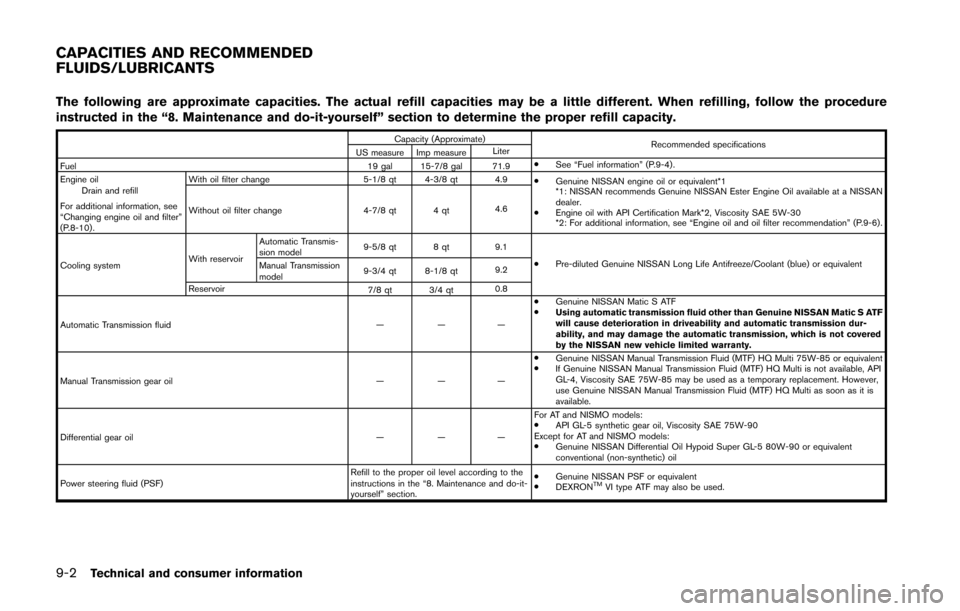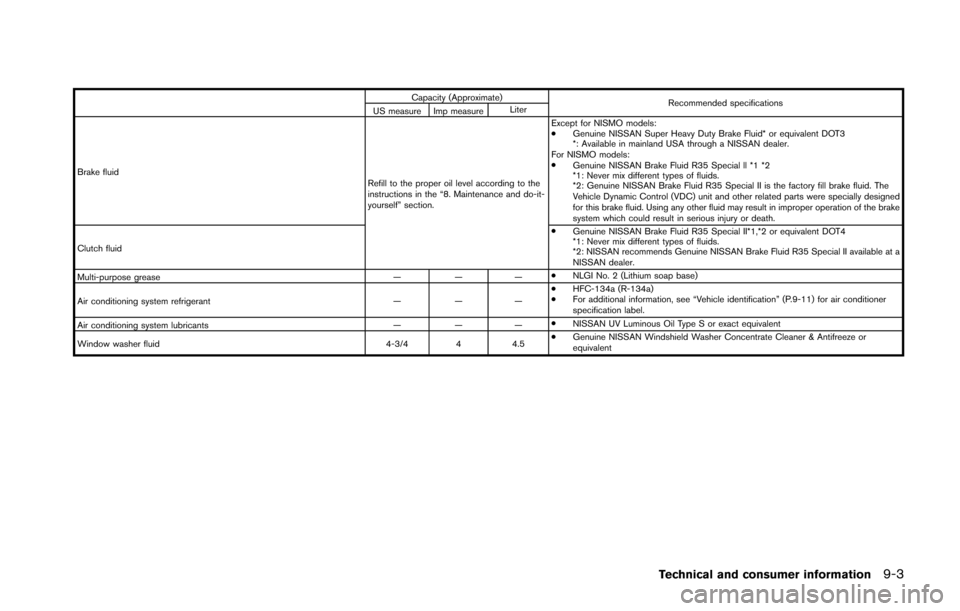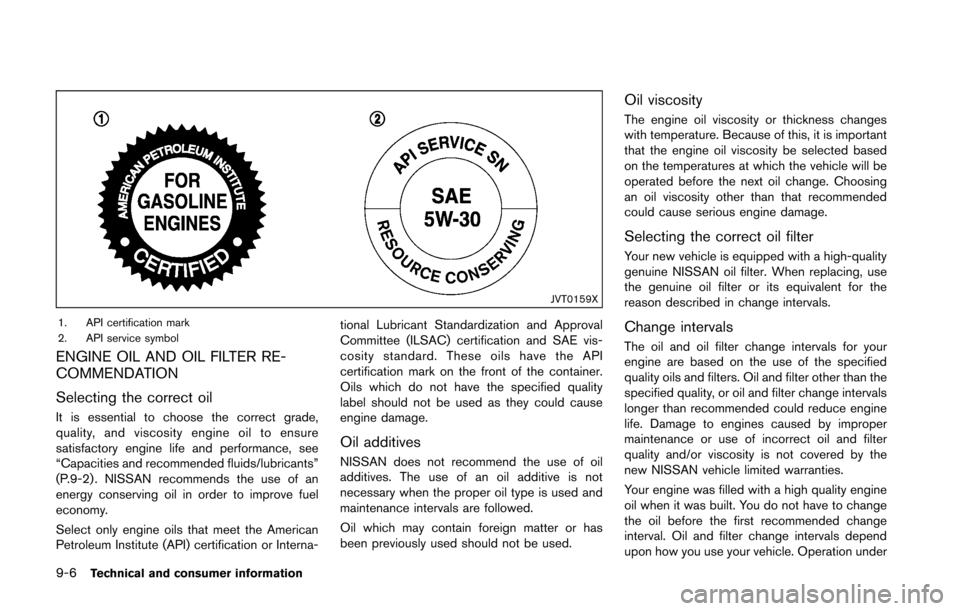2016 NISSAN 370Z COUPE oil type
[x] Cancel search: oil typePage 326 of 428

SCE0661
Installing the spare tire
The T-type spare tire is designed for
emergency use. (See specific instructions
under the heading “Wheels and tires” (P.8-
30) .)
1. Clean any mud or dirt from the surfacebetween the wheel and hub.
2. Carefully put the spare tire on and tighten the wheel nuts finger tight. Check that all the
wheel nuts contact the wheel surface
horizontally.
Models equipped with different sized
tires in the front and rear:
When replacing a front tire, make sure that the hole in the spare tire wheel is aligned
with the pin on the brake rotor.
3. With the wheel nut wrench, tighten wheel nuts alternately and evenly in the sequence
as illustrated (
*1,*2,*3,*4,*5) until
they are tight.
4. Lower the vehicle slowly until the tire touches the ground. Then, with the wheel
nut wrench, tighten the wheel nuts securely
in the sequence as illustrated. Lower the
vehicle completely.
WARNING
.Incorrect wheel nuts or improperly
tightened wheel nuts can cause the
wheel to become loose or come off.
This could cause an accident.
. Do not use oil or grease on the
wheel studs or nuts. This could
cause the nuts to become loose.
. Retighten the wheel nuts when the
vehicle has been driven for 600
miles (1,000 km) (also in cases of a
flat tire, etc.) .
. As soon as possible, tighten the wheel
nuts to the specified torque with a torque wrench.
Wheel nut tightening torque:
80 ft-lb (108 N·m)
The wheel nuts must be kept tightened
to specification at all times. It is
recommended that wheel nuts be tigh-
tened to specifications at each lubrica-
tion interval.
. Adjust tire pressure to the COLD pres-
sure.
COLD pressure:
After the vehicle has been parked for
three hours or more or driven less than
1 mile (1.6 km) .
COLD tire pressures are shown on the
Tire and Loading Information label
affixed to the driver side center pillar.
Stowing the damaged tire and tools
Coupe models:
1. Securely store the damaged tire and jacking
tools in the storage area.
2. Place the spare tire cover and the cargo room carpet over the damaged tire.
3. Close the rear hatch.
In case of emergency6-7
Page 393 of 428

9-2Technical and consumer information
The following are approximate capacities. The actual refill capacities may be a little different. When refilling, follow the procedure
instructed in the “8. Maintenance and do-it-yourself” section to determine the proper refill capacity.
Capacity (Approximate)Recommended specifications
US measure Imp measure Liter
Fuel 19 gal 15-7/8 gal 71.9.
See “Fuel information” (P.9-4) .
Engine oil Drain and refill
For additional information, see
“Changing engine oil and filter”
(P.8-10). With oil filter change
5-1/8 qt 4-3/8 qt 4.9
.
Genuine NISSAN engine oil or equivalent*1
*1: NISSAN recommends Genuine NISSAN Ester Engine Oil available at a NISSAN
dealer.
. Engine oil with API Certification Mark*2, Viscosity SAE 5W-30
*2: For additional information, see “Engine oil and oil filter recommendation” (P.9-6) .
Without oil filter change
4-7/8 qt 4 qt4.6
Cooling system With reservoirAutomatic Transmis-
sion model
9-5/8 qt 8 qt
9.1
.Pre-diluted Genuine NISSAN Long Life Antifreeze/Coolant (blue) or equivalent
Manual Transmission
model 9-3/4 qt 8-1/8 qt
9.2
Reservoir 7/8 qt 3/4 qt0.8
Automatic Transmission fluid ———.
Genuine NISSAN Matic S ATF
. Using automatic transmission fluid other than Genuine NISSAN Matic S ATF
will cause deterioration in driveability and automatic transmission dur-
ability, and may damage the automatic transmission, which is not covered
by the NISSAN new vehicle limited warranty.
Manual Transmission gear oil ———.
Genuine NISSAN Manual Transmission Fluid (MTF) HQ Multi 75W-85 or equivalent
. If Genuine NISSAN Manual Transmission Fluid (MTF) HQ Multi is not available, API
GL-4, Viscosity SAE 75W-85 may be used as a temporary replacement. However,
use Genuine NISSAN Manual Transmission Fluid (MTF) HQ Multi as soon as it is
available.
Differential gear oil ———For AT and NISMO models:
.
API GL-5 synthetic gear oil, Viscosity SAE 75W-90
Except for AT and NISMO models:
. Genuine NISSAN Differential Oil Hypoid Super GL-5 80W-90 or equivalent
conventional (non-synthetic) oil
Power steering fluid (PSF) Refill to the proper oil level according to the
instructions in the “8. Maintenance and do-it-
yourself” section..
Genuine NISSAN PSF or equivalent
. DEXRON
TMVI type ATF may also be used.
CAPACITIES AND RECOMMENDED
FLUIDS/LUBRICANTS
Page 394 of 428

Capacity (Approximate)Recommended specifications
US measure Imp measure Liter
Brake fluid Refill to the proper oil level according to the
instructions in the “8. Maintenance and do-it-
yourself” section.Except for NISMO models:
.
Genuine NISSAN Super Heavy Duty Brake Fluid* or equivalent DOT3
*: Available in mainland USA through a NISSAN dealer.
For NISMO models:
. Genuine NISSAN Brake Fluid R35 Special ll *1 *2
*1: Never mix different types of fluids.
*2: Genuine NISSAN Brake Fluid R35 Special II is the factory fill brake fluid. The
Vehicle Dynamic Control (VDC) unit and other related parts were specially designed
for this brake fluid. Using any other fluid may result in improper operation of the brake
system which could result in serious injury or death.
Clutch fluid .
Genuine NISSAN Brake Fluid R35 Special II*1,*2 or equivalent DOT4
*1: Never mix different types of fluids.
*2: NISSAN recommends Genuine NISSAN Brake Fluid R35 Special II available at a
NISSAN dealer.
Multi-purpose grease ———.
NLGI No. 2 (Lithium soap base)
Air conditioning system refrigerant ———.
HFC-134a (R-134a)
. For additional information, see “Vehicle identification” (P.9-11) for air conditioner
specification label.
Air conditioning system lubricants ———.
NISSAN UV Luminous Oil Type S or exact equivalent
Window washer fluid 4-3/444.5.
Genuine NISSAN Windshield Washer Concentrate Cleaner & Antifreeze or
equivalent
Technical and consumer information9-3
Page 397 of 428

9-6Technical and consumer information
JVT0159X
1. API certification mark
2. API service symbol
ENGINE OIL AND OIL FILTER RE-
COMMENDATION
Selecting the correct oil
It is essential to choose the correct grade,
quality, and viscosity engine oil to ensure
satisfactory engine life and performance, see
“Capacities and recommended fluids/lubricants”
(P.9-2) . NISSAN recommends the use of an
energy conserving oil in order to improve fuel
economy.
Select only engine oils that meet the American
Petroleum Institute (API) certification or Interna-tional Lubricant Standardization and Approval
Committee (ILSAC) certification and SAE vis-
cosity standard. These oils have the API
certification mark on the front of the container.
Oils which do not have the specified quality
label should not be used as they could cause
engine damage.
Oil additives
NISSAN does not recommend the use of oil
additives. The use of an oil additive is not
necessary when the proper oil type is used and
maintenance intervals are followed.
Oil which may contain foreign matter or has
been previously used should not be used.
Oil viscosity
The engine oil viscosity or thickness changes
with temperature. Because of this, it is important
that the engine oil viscosity be selected based
on the temperatures at which the vehicle will be
operated before the next oil change. Choosing
an oil viscosity other than that recommended
could cause serious engine damage.
Selecting the correct oil filter
Your new vehicle is equipped with a high-quality
genuine NISSAN oil filter. When replacing, use
the genuine oil filter or its equivalent for the
reason described in change intervals.
Change intervals
The oil and oil filter change intervals for your
engine are based on the use of the specified
quality oils and filters. Oil and filter other than the
specified quality, or oil and filter change intervals
longer than recommended could reduce engine
life. Damage to engines caused by improper
maintenance or use of incorrect oil and filter
quality and/or viscosity is not covered by the
new NISSAN vehicle limited warranties.
Your engine was filled with a high quality engine
oil when it was built. You do not have to change
the oil before the first recommended change
interval. Oil and filter change intervals depend
upon how you use your vehicle. Operation under
Page 398 of 428

the following conditions may require more
frequent oil and filter changes.
.repeated short distance driving at cold
outside temperatures,
. driving in dusty conditions,
. extensive idling,
. stop and go “rush hour” traffic,
Refer to the “NISSAN Service and Maintenance
Guide” for the maintenance schedule.
AIR CONDITIONING SYSTEM RE-
FRIGERANT AND LUBRICANT RE-
COMMENDATIONS
The air conditioning system in your
NISSAN vehicle must be charged with the
refrigerant HFC-134a (R-134a) and the
lubricant, NISSAN UV Luminous Oil Type
S or the exact equivalents.
CAUTION
The use of any other refrigerant or
lubricant will cause severe damage to
the air conditioning system and will
require the replacement of all air con-
ditioner system components.
The refrigerant HFC-134a (R-134a) in your
NISSAN vehicle will not harm the earth’s ozone layer. Although this refrigerant does not affect
the earth’s atmosphere, certain governmental
regulations require the recovery and recycling of
any refrigerant during automotive air condition-
ing system service. Your NISSAN dealer has the
trained technicians and equipment needed to
recover and recycle your air conditioning system
refrigerant.
Contact a NISSAN dealer when servicing your
air conditioning system.
Technical and consumer information9-7